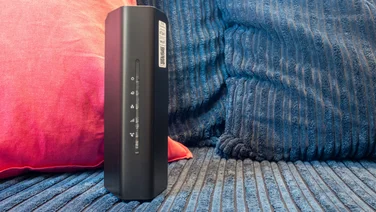To help us provide you with free impartial advice, we may earn a commission if you buy through links on our site. Learn more















- Neat low-profile design
- Easy to manage
- Built-in VPN server
- Mediocre speeds
- Lacks MU-MIMO
- No USB ports
The Archer AX10 is one of the cheapest Wi-Fi 6 routers around. It looks a lot like TP-Link’s unassuming Archer AX50 but it costs a mere £64 and has an even more basic hardware spec.
Happily, the most important features remain. There’s full Wi-Fi 6 support with a 5GHz radio rated at up to 1.2Gbits/sec and decent wired connectivity, courtesy of four Gigabit Ethernet ports. You can manage your network from either a web browser or the TP-Link Tether mobile app, and the software unexpectedly includes an inbound VPN server, too.
READ NEXT: Check out our favourite VPNs
TP-Link Archer AX10 review: What you need to know
What we’re dealing with here is a dual-band 802.11ax router. Its Wi-Fi provision is fairly modest: as I’ve noted above, TP-Link claims speeds of up to 1.2Gbits/sec on the 5GHz band, while the 2.4GHz band promises a maximum of 300Mbits/sec. The four rear-mounted antennas support 4×4 MIMO to help maximise connection speeds, but multi-user MIMO doesn’t make it into the package.
Beyond that, it’s a pretty minimal proposition. The AX10 has no USB ports for file sharing or 4G failover and you won’t find anything in the way of network security services. Still, while networking geeks may find the AX10 uninspiring, there’s something to be said for a simple router that provides Wi-Fi 6 at a low price.
TP-Link Archer AX10 review: Price and competition
The AX10 is deliciously affordable but it isn’t the cheapest Wi-Fi 6 router you can get: that’s the understated Honor Router 3, which does an impressively comprehensive job for £40. For just a little more, meanwhile, you can get the Netgear Nighthawk AX4 (currently £79), although that model’s now getting long in the tooth and doesn’t compare favourably to newer routers.
It’s also worth checking out the Linksys MR7350. At £108, this isn’t a direct competitor to the AX10 but it’s still good value and delivers some of the best speeds we’ve seen at this lower end of the market. If you’re feeling flush, the Asus RT-AX82U provides similar performance to the Linksys along with a much broader feature set for £173.
If coverage is a priority, you might also consider the Netgear Orbi RBK352 mesh system. It isn’t particularly fast, but the multi-node design helps ensure you get a strong wireless signal wherever you need it. A two-unit pack costs £178, while the three-node option sells for £270.
READ NEXT: The best antivirus software you can buy right now
TP-Link Archer AX10 review: The hardware
Like the TP-Link AX50, the TP-Link AX10 has a low-rise, elongated case that measures 260mm across but only 135mm deep. That makes it easy to fit into your home, and the four antennas only project 155mm upwards. As Wi-Fi 6 routers go, it’s nicely inconspicuous, although the glossy plastic top is a little prone to distracting reflections.
At the front sit six LEDs with cryptic icons; once you’ve decoded these, you can glance at the lights to discover what’s going on with power, 2.4GHz and 5GHz radio connections, internet, Ethernet and WPS. At the rear, four Gigabit LAN ports sit next to a dedicated WAN connector and, nearby, you’ll find a sticky-out button that turns on WPS pairing for up to five minutes, a recessed reset button and a power button. That’s really all there is to the AX10.
TP-Link Archer AX10 review: Setup and software
I used the TP-Link Tether app on Android to set up the AX10. This allowed me to scan a QR code on the back of the router to make the initial connection, after which I was invited to pick new names and passphrases for the 2.4GHz and 5GHz networks (once you’re past the initial setup you can choose whether or not to combine these under a single SSID).
As usual, there’s then a slightly clunky moment when the router reboots and you have to reconnect using the new network details, but it’s plain sailing after that. The Tether app invites you to bind your newly configured router to a TP-Link account, which enables remote management and lets you through to the main management interface.
We’ve no complaints about the design or responsiveness of the app. It’s a convenient way to check on your network status, see who’s connected, and control the guest network. You can also use it to create and update parental control profiles, although the controls themselves are very basic, only supporting simple time limits and blocking specific URLs.















For most management functions you’ll need to fire up the web interface but this is just as easy to use, with a nice clear tabbed design. It takes just a few clicks to customise your DHCP and DNS settings, reserve IP addresses and set up port forwarding for specific devices and services.
You can also enable WPA3 and experiment with different Wi-Fi settings, but there’s not much scope for a performance boost as the 5GHz radio only operates between channel 36 and channel 48 and doesn’t support the optional 160MHz channel mode. As a compromise, you can use the QoS settings to give traffic priority to particular clients, either permanently or for a limited period.
There’s also an option to review which website your kids have been visiting, and I was pleasantly surprised to find that the AX10 even includes a VPN server, which you can use to access your home network from anywhere on the internet. It’s conveniently partnered with integrated dynamic DNS, using either DynDNS.org, No-IP.com or TP-Link’s own service.















At the end of the day, though, this is a budget router. In the absence of USB ports there’s naturally no sort of file or media server. Nor will you find much in the way of network security functions, beyond a simple, non-configurable firewall. And I was annoyed to discover that, although TP-Link advertises the AX10 as supporting the company’s OneMesh technology, this isn’t enabled with the current firmware so you can’t currently use a second unit as a zero-configuration extender, as is possible with routers from Asus, Honor and others.
READ NEXT: Get the best speeds with these top broadband services
TP-Link Archer AX10 review: Performance
Wi-Fi 6 normally represents a step up in performance from 802.11ac, but the AX10 isn’t really built for maximum speeds. A purported data rate of 1.2Gbits/sec is nothing special for a 5GHz radio – most flagship models claim four times the bandwidth – and it doesn’t help that the channel width is limited to 80MHz, with no access to the high-frequency DFS channels that can reduce interference.


To discover how the AX10 fares in actual usage, I carried out my usual set of tests. After setting up the router in the usual spot in the study, I walked around my home with a 2020 HP Elite Dragonfly laptop, which has an integrated Intel AX200 2×2 160MHz card. From various locations, I copied a series of files to and from a NAS appliance (connected directly to the router via Ethernet) over the 5GHz network. Here are the average file-transfer speeds I saw, along with those from a selection of alternative routers for context:
For the most part, the Archer AX10 consistently outclassed the Nighthawk RAX40, falling behind only for same-room transfers. It often bested the Honor Router 3 as well, but I’d have to say that victory was more equivocal. The Honor projected a stronger signal to the bathroom at the far end of the house – probably thanks to its 160MHz channel width – and it also supports MU-MIMO, meaning it should be able to divide up the available bandwidth more smoothly when multiple clients want to download files or stream video at once.
Unsurprisingly, none of these sub-£100 routers matched the Asus and Linksys models. Those may be decidedly more costly, but the more expensive hardware opens up much more of the potential of Wi-Fi 6, especially for read performance.
TP-Link Archer AX10 review: Verdict
The AX10 does a lot for a low price. Unfortunately for TP-Link, it’s up against an incredibly strong competitor in the shape of the Honor Router 3. While the Honor’s Wi-Fi speeds proved overall slightly slower than the AX10’s, it still offers all the performance most households will need. The signal holds up better at long range, too, and if you need a little extra reach then Honor’s mesh networking feature works right now. Throw in MU-MIMO support and the Archer AX10 is left looking a little outclassed – and did I mention that the Honor is £24 cheaper?
Yet on its own terms TP-Link’s contender puts in a creditable showing. It’s reasonably speedy for the price, it’s easy to set up and manage and, for more advanced users, the VPN server is a great bonus. When you’re buying a budget router you have to expect compromises, but if you can look past the TP-Link Archer AX10’s particular shortcomings, it makes for a very likeable home Wi-Fi solution.







